Who Walks Down the Aisle with the Mother of the Bride? A Guide to Wedding Traditions
When planning a wedding ceremony, one detail that often comes up is who will walk the mother of the bride down the aisle. Traditionally, a groomsman is chosen for this honor, giving him a special moment and ensuring he plays an active part in the proceedings. This choice often highlights the unity between the family and the wedding party, making it a cherished moment for many.
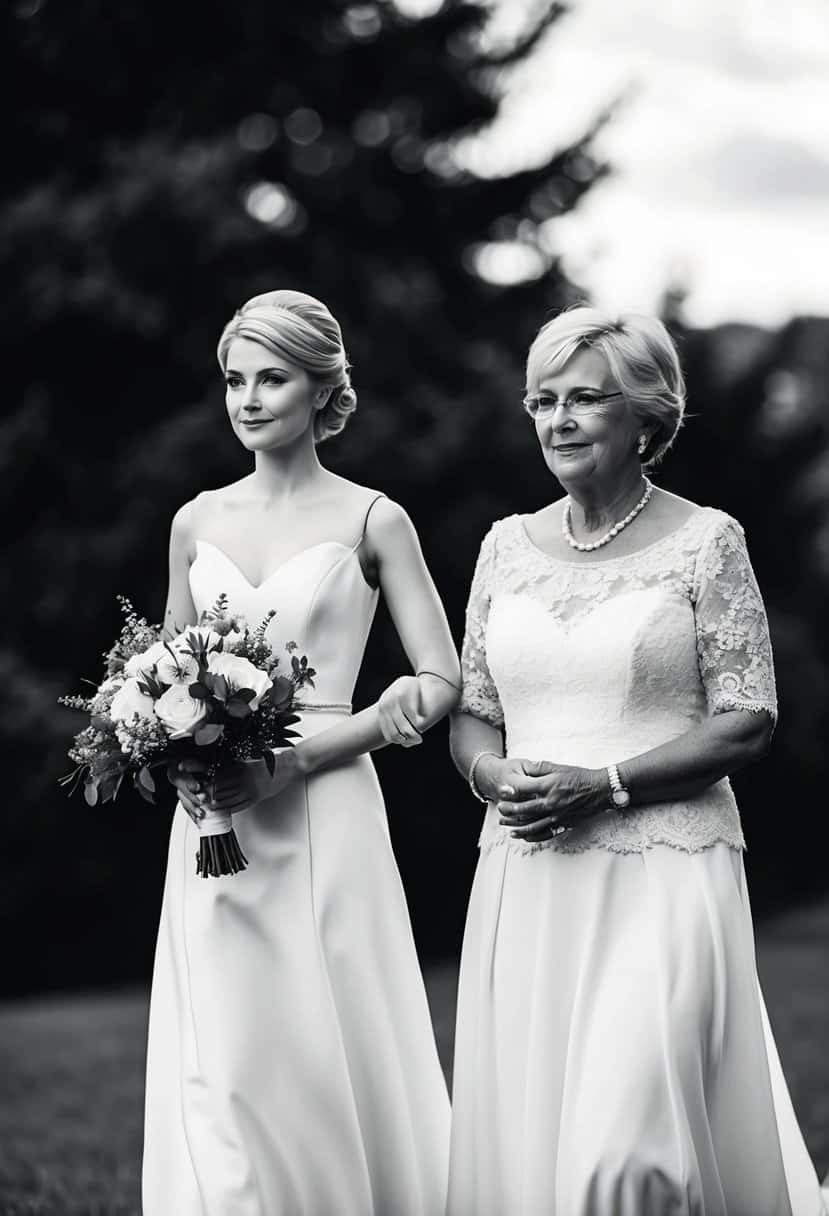
If you’re looking for a more personal touch, the mother of the bride might be escorted by a family member such as her son or brother. This option can beautifully highlight close family bonds and allow a significant person in her life to have a key role in the ceremony.
For those who enjoy doing things their own way, the mother of the bride may choose to walk down the aisle on her own. It’s a testament to her independence and strength, starting off the wedding ceremony with a touch of personal significance. Each option offers a unique way to celebrate her presence on this special day, making her feel honored and appreciated.
The Role of the Mother of the Bride

Your role as the mother of the bride is both meaningful and special. You are a central figure in the wedding and have several important duties.
From helping to plan the ceremony to being there for your daughter, your presence is cherished.
Family dynamics might come into play throughout this event. You may work alongside other family members, like the father of the bride or siblings, to ensure everything runs smoothly. Your support can strengthen the bonds between you and your family during this special time.
Traditionally, you can be a part of the wedding processional. You walk down the aisle before the bridal party. This is often done with the help of a close male relative, such as a son or brother.
Your involvement also extends to helping with the planning. You might assist in choosing the wedding dress, creating the guest list, or selecting decorations. Your insight and experience are valuable in shaping your daughter’s big day.
- Supporting your daughter
- Participating in the processional
- Helping plan the wedding
In all these roles, you play a crucial part in one of the most significant days of your family’s life. Your guidance and love help create a memorable experience for everyone involved.
Wedding Processional Basics
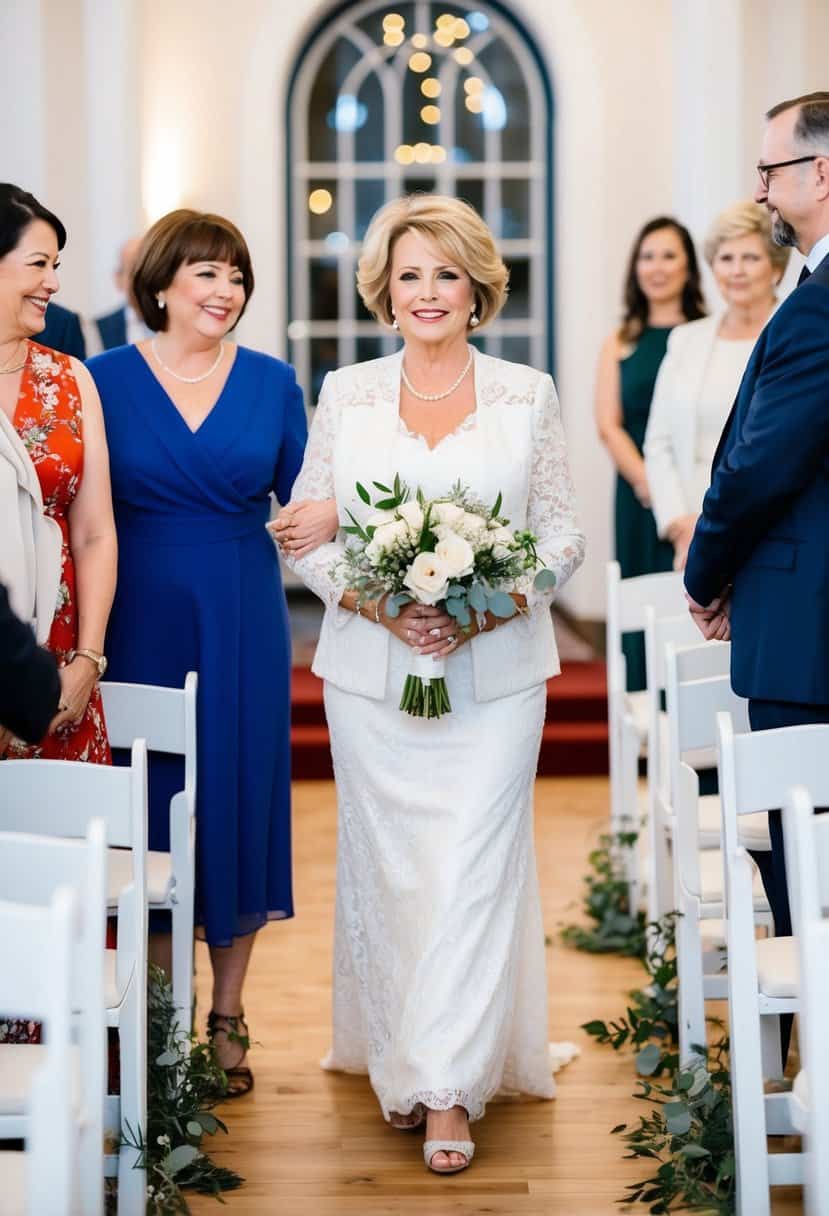
Understanding the wedding processional order and the role of music is essential. Both elements help create a meaningful and organized ceremony, setting the tone and pace for your big day.
Order and Participants
The wedding processional order involves several key participants. Typically, the ceremony starts with the officiant walking down the aisle. This signals that the event is starting.
Following the officiant, grandparents and parents of the couple usually make their entrance.
Next, the groom and groomsmen may already be at the altar, or they might walk with bridesmaids.
The bride’s mother often has a special role. She’s usually escorted by an usher or a family member close to her. Her entrance is important, as it holds emotional significance and acknowledges her key role in the wedding.
After her, bridesmaids and the maid or matron of honor will walk down the aisle. Finally, the bride makes her entrance, possibly with her father or another close relative.
The order helps create a smooth flow for the ceremony and makes sure everyone is where they need to be.
Processional Music and Timing
Music plays a crucial role in the wedding processional. It sets the mood and highlights each part of the ceremony.
Usually, different songs or pieces of music play for various parts of the processional. For instance, grandparents and parents might walk to one song, while the bridal party and the bride have their own selections.
Timing is also key. You want the music to match the pace of the walk.
It helps to practice beforehand to ensure smooth and coordinated movement down the aisle. This practice ensures no awkward pauses or rushed entrances.
Proper music choices and timing enhance the ceremony’s overall experience, making it memorable for everyone involved.
Cultural and Religious Variations
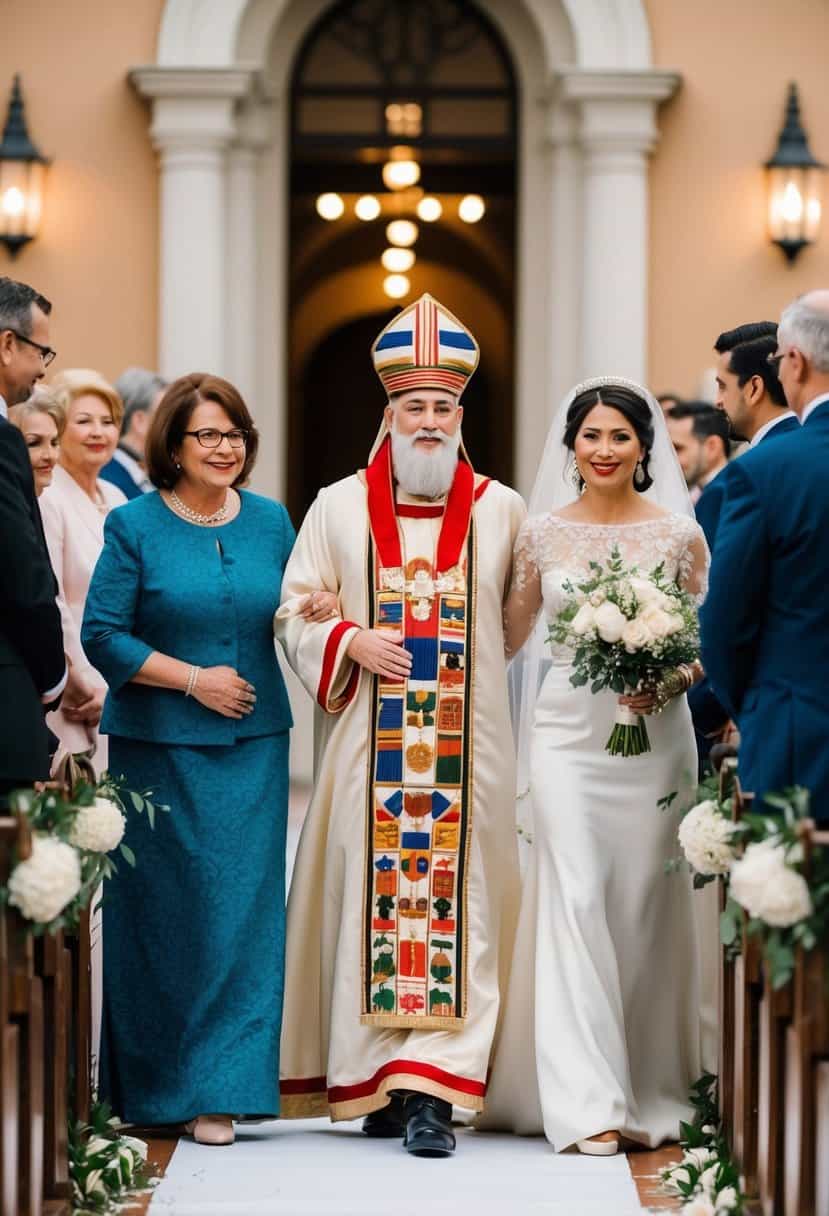
When planning a wedding, the order of who walks down the aisle can vary greatly depending on cultural and religious traditions. Understanding these customs can help you navigate the unique aspects of your wedding ceremony, whether it’s a Christian ceremony, a Jewish wedding, a Hindu celebration, or a modern approach.
Christian Wedding Processionals
In a Christian wedding ceremony, the processional often begins with the officiant. If they walk down the aisle rather than entering from the side, their presence signals that the wedding is about to begin.
Typically, the groomsmen enter next, sometimes alongside the groom. Following them are the bridesmaids, often paired with the groomsmen.
One key element is the entrance of the bride‘s mother. She usually walks down the aisle before the bridal party and is often escorted by a close family member. This moment signifies that the ceremony is soon to begin and holds emotional importance in many Christian weddings.
Jewish Wedding Traditions
Jewish weddings have their own unique processional order. The ceremony can start with the entrance of both sets of grandparents. They are usually followed by the parents of the couple, who often walk together with the bride or groom.
During traditional Jewish ceremonies, the processional includes the rabbi and cantor, who may choose to walk down the aisle or enter from the side. Another unique feature is the couple walking down the aisle under the chuppah, a canopy that symbolizes their future home.
Hindu Wedding Customs
Hindu wedding processionals are marked by vibrant and elaborate festivities. An important step is the baraat, where the groom often arrives in a festive procession, traditionally on a horse or an elaborate vehicle. This lively event involves music and dancing, creating a joyous atmosphere.
Upon arrival, the groom is welcomed at the entrance of the venue, which leads to the commencement of the ceremony under the mandap—a decorated canopy. Family members often accompany the bride as she approaches, enhancing the celebration and cultural richness of Hindu weddings.
Modern and Nondenominational Approaches
In modern and nondenominational wedding processionals, traditions are often adapted to fit personal preferences. This flexibility allows you to create a ceremony that reflects both your personalities and beliefs.
The order can be unique, combining elements from multiple cultures or religions to create a special day.
A common trend is for both parents to walk with the bride down the aisle. This can feel more inclusive and personal. You might also see variations where the couple chooses new roles for friends and family, making the processional truly their own.
Special Moments and Considerations
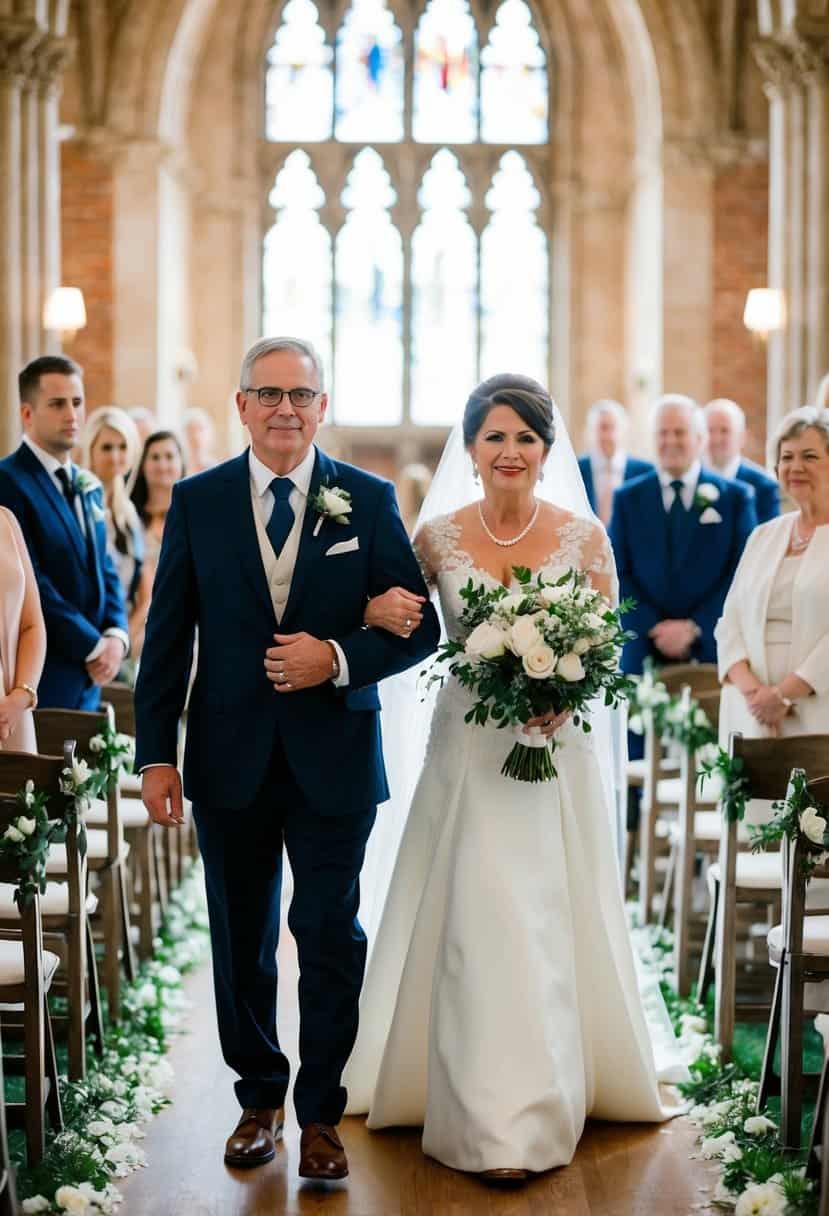
Choosing who walks the mother of the bride down the aisle is a significant decision. Often, it reflects family dynamics and can create special moments that the family cherishes forever.
Walking Independently or With Both Parents
Sometimes, the mother of the bride might choose to walk down the aisle independently. This choice displays her strength and independence. It allows her a moment to shine on her own and creates a memorable moment for everyone witnessing it.
Alternatively, she may choose to walk with both her parents, if possible. This can be a touching scene, symbolizing the love and support she receives from both sides of her family. Walking with both parents enables her whole family to share this meaningful moment.
Family Dynamic Complications
Family dynamics can sometimes make the decision complicated. Divorces, remarriages, and other factors might affect who the mother of the bride feels comfortable with during this special moment.
If the bride’s family includes step-parents or estranged relatives, decisions may need to be handled with empathy and understanding.
Open communication and respect for everyone’s feelings can help navigate challenging situations smoothly.
Discuss and acknowledge these dynamics early on to help the mother of the bride feel at ease and make the event as harmonious as possible for everyone involved.
Logistics and Etiquette
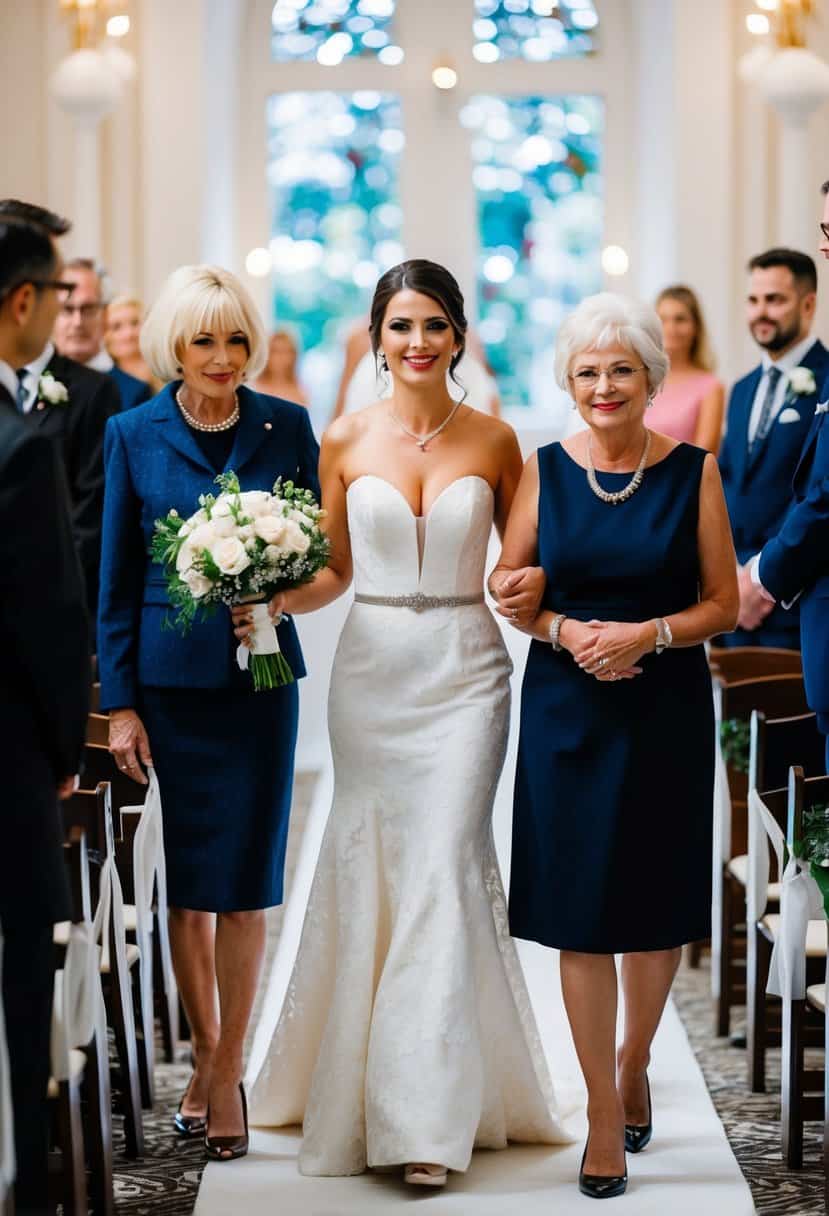
On your wedding day, the processional order is important. The mother of the bride typically walks down the aisle before the bride, often escorted by a close male relative, like the father of the groom or a groomsman. This can be a special moment for her, so it’s important to plan it carefully.
If the father of the bride is available, he might accompany her. In some cases, a son or another close relative might step in. Once she reaches the front, she takes her seat on the left side.
The groom’s parents usually follow, taking their positions next to her. The officiant, groom, and best man are usually already at the altar. This setup allows for a smooth transition when the ceremony begins.
Bridesmaids and groomsmen typically follow next, walking in pairs. This adds a sense of structure to the event and helps set the stage for the bride’s grand entrance.
Next come the flower girls and ring bearers, who sprinkle flower petals or carry rings down the aisle. They add charm and excitement to the procession. After them, the maid of honor walks in alone, leading to the final entrance of the bride.
In Jewish weddings, grandparents and parents have a special role, sometimes under a chuppah. Being aware of such customs can help your ceremony flow smoothly and respectfully.




